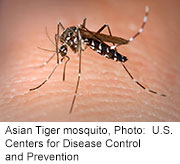
FRIDAY, Aug. 9 (HealthDay News) — What’s striped black-and-white, packs a nasty bite and is a tireless spreader of disease? No, it’s not a B-movie horror creature — it’s the Asian tiger mosquito.
And though a relative newcomer to the American scene, experts now warn that this intruder is starting to create a fearsome buzz, with the potential to cause havoc across the United States. So far, however, it hasn’t led to widespread disease in this country.
“What we have here is an invasive daytime-feeding, disease-carrying mosquito that, since it first arrived on the East Coast in the 1980s, has been pretty aggressive in mowing down its natural competitors,” said Gabe Hamer, a clinical assistant professor in the department of entomology at Texas A&M University. “And now it’s really starting to move through the country in full force.”
“That makes it, at the very least, a nuisance and an annoyance,” Hamer explained. “And at worst, a serious vector for major pathogens.”
On its Asian home turf, the mosquito is a well-known carrier of dengue fever, with West Nile fever, yellow fever, and encephalitis among the other debilitating illnesses for which it has been pegged as a transmitter.
According to the U.S. Centers for Disease Control and Prevention, the mosquito has so far been identified as a host for five different viruses in the United States. Two of those — encephalomyelitis and Cache Valley — can infect humans, while the others are a threat to dogs, cats, birds and other animals.
But U.S. experts are perhaps most alarmed that this mosquito potentially could become a prime North American vector for a particularly nasty joint and muscle pain illness for which there is neither a vaccine nor treatment: the Chikungunya virus.
Such concerns have escalated in light of recent research, such as that funded by the U.S. National Institute for Food and Agriculture, and reported in the January issue of PLoS Neglected Tropical Diseases, which cautions that an imminent mosquito-driven American outbreak of the Chikungunya virus is a very real threat.
“The ongoing invasion of the Asian tiger mosquito in the U.S.A. represents an important risk,” agreed Diego Ruiz-Moreno, a postdoctoral associate in the department of ecology and evolutionary biology at Cornell University, who led the recent study. “Mainly because of the potential for disease to spread.”
Otherwise known as Aedes albopictus, the CDC notes that the Asian tiger mosquito was first spotted on the U.S. mainland in 1985. Since that initial Houston sighting, it has spread across 26 states, moving as far north as Chicago, as far east as Pennsylvania and New Jersey, as far west as Nebraska, and across a broad swath of the South, including Florida, Georgia, South Carolina and Tennessee.
Add now, Hamer said, California has been added to the list.
“The thing about this particular species is that it breeds and travels very well in small warm container environments,” with an uncanny ability to adapt and thrive in shifting temperatures, he explained. “And it turns out that humans are really good at providing those spaces. A tire, a flower pot, a bucket, urns at cemeteries. All these are classic holders of stagnant water, which is all they need to hop from one country to another, one state to another.”
And so, Hamer noted, “it’s been going everywhere. Europe, certain parts of Africa, South America, and now here,” where its aggressive mating habits have run roughshod over other local mosquito populations (such as the yellow fever mosquito), essentially replacing one illness-bearing mosquito threat with another.
But has the Asian tiger mosquito’s troublesome potential really lived up to its hype?
“I would say that for the moment, while the concern is real and we should be paying a lot of attention to this particular mosquito, so far it doesn’t seem to be playing a major pathogen-spreading role in the U.S.,” Hamer suggested.
“Chikungunya hasn’t come to the U.S. yet, and that’s comforting. At the same time, this is a very aggressive mosquito that feeds during the day, rather than from dusk to dawn, which is different from the way West Nile virus was spread, by a mosquito that fed at night. So we’re talking about the need for a kind of all-day vigilance against getting bitten that the American public is not really familiar with,” he pointed out.
“So the bottom line is that if chikungunya does show up, this mosquito could be the vector for it,” Hamer said. “And that means it’s important that we have protective virus surveillance up and running throughout the country, which we already do. So that once things show up we can react quickly.”
But as experts watch and wait, what can people do to protect themselves?
According to Ruiz-Moreno: “The best strategy is to reduce exposure to potentially infective mosquitoes, either by avoiding contact or reducing mosquito population in the wild. At home, we recommend removing all sources of standing water. And when going outside we need to wear insect repellent and cover up with long sleeves and pants to avoid mosquito bites.”
More information
For more on the Asian tiger mosquito, visit the U.S. Centers for Disease Control and Prevention.
Copyright © 2025 HealthDay. All rights reserved.

